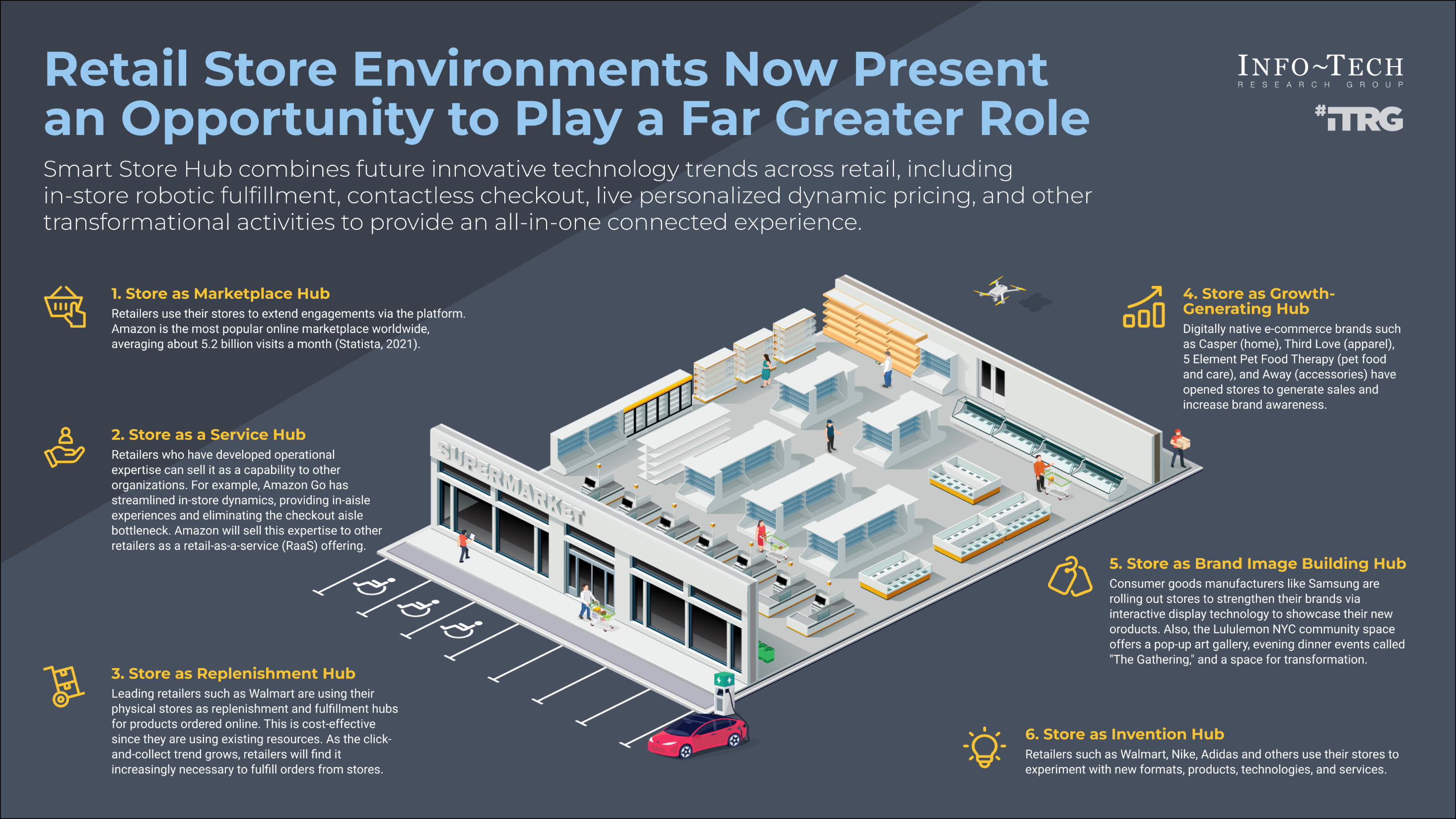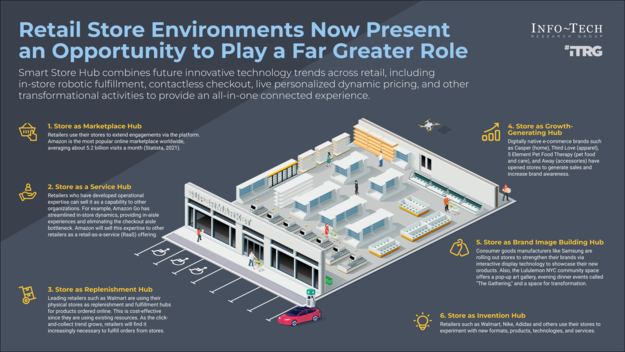A clear understanding of the business goals is a critical component for modernizing store technology.
CIOs struggle to:
- Align new technology with business goals.
- Build a defensible business case with a favorable return on investment (ROI) that delivers value.
- Navigate the optimal technology landscape from trends, vendors, solutions, and integration and how different technologies interconnect.
Our Advice
Critical Insight
High-performing IT teams can guide the organization through retail store digital transformations by aligning technology investment with business objectives. Before embarking on a modernization strategy, CIOs must answer this question: what is the business goal of modernizing store technology?
Impact and Result
Formulate an effective plan that allows your organization to modernize store technology that aligns business and IT goals by:
- Enlisting business partners to ensure clarity on the intended business value that will be created by modernizing store technology.
- Leaning on proven methodologies to identify the range of relevant technologies that will allow the organization to achieve its business goals.
- Prioritizing key initiatives based on value and feasibility.
The Retail Store of the Future
Accelerate your retail store modernization.
Analyst perspective
Drive store modernization.
The pace of technological change is accelerating, and CIOs must be able to confidently invest in strategically beneficial solutions that bring value to the business. Cool technologies are continuously emerging, and retailers are inundated with information about technology that claims to address all their challenges. CIOs need to weigh the risk of missing an opportunity against the potential of getting involved in a trend that doesn't offer a return on investment.
As CIOs must justify the investment needed to modernize stores, it is imperative that the business teams have a clear goal. Plans with measurable goals that clearly connect new technology investment to tangible business outcomes have a higher likelihood of success.
Retailers who are investing in modernizing their store technologies and reimagining the customer value proposition are benefiting by becoming more operationally efficient and are positioned to quickly adopt new technology at a faster rate as it continues to evolve. Developing a plan that is aligned with business goals, whilst assessing the feasibility of new technology, will position organizations for success; we are here to help.

Donnafay MacDonald
Research Director, Industry Research
Info-Tech Research Group
Executive summary
| Your Challenge | Common Obstacles | Info-Tech's Approach |
|
A clear understanding of business goals is a critical component for modernizing store technology. CIOs struggle to:
|
|
Formulate an effective plan that allows your organization to modernize store technology that aligns business and IT goals:
|
Info-Tech Insight
A successful strategy should be phased and purpose-driven prioritizing seamless integration, scalability, operational continuity, and security while ultimately delivering measurable ROI to the business. Before launching any store technology modernization, CIOs must clearly define the business objective behind it.
Your challenge
CIOs struggle to justify the technology investment to modernize stores.
CIOs often find it challenging to align their organizations' unique technology needs into existing enterprise infrastructure.
There are three specific challenges to address:
- Lack of Clarity: Business goals what are they trying to solve, improve, etc.
- Fragmented ROI: Disjointed ROI that cannot easily measure the effectiveness of technology investment across the organization. Store technology not only impacts store operations, but it also impacts product and supply chain management.
- Feasibility Uncertainty: Integration uncertainty and the complications of integrating into existing, possible legacy systems that do not easily support new technology (speed, connectivity, etc.).
Common obstacles
The rapid evolution of the digital marketplace amplifies the urgency to evolve.
- Organizations must remain agile to stay competitive in a fast-evolving industry that is shaped by shifting consumer behaviors, competitor pressures, and changing market trends. CIOs must leverage technological advancements that support business goals, equipping their organization with the tools needed to swiftly adapt to change and seize emerging opportunities.
- CIOs often face competing priorities in balancing the need to maintain system reliability while also driving innovation. Aligning technology with business goals can bring focus to how store technology investment can directly improve the organization's market position and deliver a measurable return on investment.
- Older systems may not be compatible or flexible enough to support modern technologies, presenting CIOs with the obstacle of assessing the feasibility of upgrading technology. Integrations can be costly and time-consuming, with a need for customization and potential enterprise architecture overhauls. As part of the feasibility assessment, CIOs must consider the risk to operations, data inconsistencies, and security vulnerabilities.
Common obstacles
Risk of failure is tangible.
17%
Percentage of technology investment not tied to business goals
(Rimini Street, 2024)
61%
Percentage of CIOs who find it challenging to prove an ROI for tech investment
(CIO, 2024)
$85B
Amount spent annually fixing technical problems from legacy code
("Legacy Versus Modern Systems," Forbes, 2024)
Prioritize in-store digital transformations
Outpace your competition.
66%
Improvement to data and analytics because of digital transformations (Statista, 2023)
up to 36%
Improvement to inventory accuracy from technology. For every 3% improvement in inventory accuracy, retailers can experience a 1% uplift in sales
(GS1 UK, n.d.)
11%
Increase in in-person visits for stores that have integrated automation technology (Statista, 2020)
"Data-driven companies are 23 times more likely to top their competitors in customer acquisition, about 19 times more likely to stay profitable, and nearly seven times more likely to retain customers."
Source: Forbes, 2023
Info-Tech's approach
Eliminate the uncertainty around in-store technology transformations.
Clarify the Vision
A well-defined business goal helps guide the investment priorities for new technology. It empowers CIOs to focus resources on initiatives that can deliver measurable value to the business.
Prove Value
Use evidence-based tools to provide a clear understanding of the potential value of new technology that will help justify the investment and reduce the uncertainty in decision-making. Leveraging case studies and developing use cases alongside the business enables CIOs to effectively evaluate the impact of new digital technology.
Bridge the Gap
Create a feasibility roadmap that prioritizes technology based on its alignment with business goals and ability to deliver measurable value.

Transform In-Store Technology and Build the Retail Store of the Future
Accelerate and optimize your retail store of the future by building a cohesive plan that delivers customer and business value.
SITUATION
- The retail competitive pressure is accelerating.
- Organizations struggle to justify the investment needed to modernize stores.
- The business lacks a clear goal and understanding of how new technology will bring value.
- Top retail competitors are already benefiting from new technologies.
- CIOs must be able to confidently invest in strategically beneficial solutions.
INSIGHT
High-performing IT teams can guide the organization through retail store digital transformations by aligning technology investment with business objectives. Before embarking on a modernization strategy, CIOs must answer the question "what is the business goal of modernizing store technology?"
Align business goals provides justification for modernization.
IDENTIFY THE BUSINESS PROBLEM
Define your business problems by engaging with the right stakeholders and align goals through transparent, ongoing communication.
Objectives
- What are business challenges
- What are business opportunities
Business Alignment
- Engage all relevant stakeholders
- Validate goals to create alignment
- Maintain communication
Together, turn challenges into opportunities that drive real, measurable outcomes.
Understand the art of the possible to guide the implementation of the latest tools.
EVALUATE USE CASES
Stay ahead by exploring real-world case studies, learning from proven insights.
Innovation Landscape
- Analyze case studies
- Focus on practical insights
- Understand the technology
Technology Alignment
- Create detailed internal use cases
- Outline expected business outcomes & success metrics
Align technologies to business needs and ensure initiatives solve real problems and deliver measurable value.
Prioritize investment and build a structured approach to modernization.
ASSESS FEASIBILITY
To ensure successful innovation, evaluate initiatives through the lens of organizational readiness.
Evaluate Initiatives
- Business value
- Financially viable
- Executive sponsorship
- Realistic integration
- Identify challenges
- Readiness for change
Ensure initiatives that bring value to the organization are cost-effective to implement and have executive support.
Guided approach to effective in-store technology investment
1. Co-Create to Accelerate
Cross-functional teams ensure diverse perspectives and help address key challenges more effectively. IT-business collaboration helps align business goals and technology needs that are driving factors of successful outcomes.
2. Align Goals
Align on the business challenges to be solved to clarify business goals. A shared understanding of priorities leads to better collaboration, efficiency, accountability, and overall success.
3. Assess Capabilities
Assessing business capabilities and value chains helps identify key strengths and weaknesses of your organization and enables your teams to focus on the most impactful business problems worth solving.
4. Review & Analyze Case Studies
Understand how retailers have applied store technology and have driven meaningful and tangible outcomes for the business.
5. Explore the Innovation Landscape
Review and evaluate retail store technology solutions that can support business objectives.
6. Develop Use Cases
Develop and refine use cases informed by the exploration of retail technologies, foundational use cases, and real-world case studies.
7. Determine Feasibility
Assess and validate the business value and technical feasibility of implementing innovative in-store technology solutions to drive customer experience and operational efficiency.
8. Review Initiative Priorities
Review and evaluate the prioritization of initiatives based on business objectives, resource capacity, and potential impact to ensure optimal value delivery and organizational focus.
Deliverables
Each step of this client advisory document is accompanied by supporting deliverables to help you accomplish your goals:
The Retail Store of the Future Planning Tool
This template provides the member with a structured approach to defining the business challenges, writing use cases, and prioritizing initiatives that technology can address in creating the retail store of the future. This document forms the foundation of what a retailer must do to justify investing in technology.
The Retail Store of The Future Activity Workbook
A PowerPoint template and sample providing the recommended structure and visuals for capturing the top retail store of the future use cases.
Measure the benefits of laying the groundwork for tech transformation
A clear roadmap for in-store tech transformation will have a measurable impact on organizational resilience.
| Project outcome | Metric |
| Aligned IT-Business Focus | Eliminate white-elephant initiatives |
| Validated Use Cases | Confidence in decision-making that solutions address real business problems |
| Cross-Functional Buy-In | Departments are actively engaged |
| Vetted Business Value | Prioritized initiatives based on business value |
| Feasibility Assessed | Initiatives can move from ideas to becoming actionable |
Info-Tech offers various levels of support to best suit your needs
| DIY Toolkit | Guided Implementation | Workshop | Executive & Technical Counseling | Consulting |
|---|---|---|---|---|
| "Our team has already made this critical project a priority. We have the time and capability, but some guidance along the way would be helpful." | "Our team knows that we need to fix a process. We need assistance to decide where we should focus. Some check-ins along the way would help keep us on track." | "We need to hit the ground running and get this project kicked off immediately. Our team has the ability to take this over once we get a framework and strategy in place. | "Our team and processes are maturing; however, to expedite the journey we'll need a seasoned practitioner to coach and validate approaches, deliverables, and opportunities." | "Our team does not have the time or the knowledge to take on this project. We need implementation assistance through the entirety of this project." |
Diagnostics and consistent frameworks are used across all five levels of support.
Info-Tech's methodology for Launch Your Retail Store of The Future
| 1. Identify business problem | 2. Evaluate use cases | 3. Assess feasibility | |
|---|---|---|---|
| Phase Steps | 1.1 Select the team 1.2 Define the business problems 1.3 Validate and assess the problem space 1.4 Assess the impact on business capabilities |
2.1 Review use cases & case studies 2.2 Review the technology landscape 2.3 Build your use cases |
3.1 Assess technology feasibility and value 3.2 Prioritize use cases |
| Phase Outcomes |
|
|
Build a repeatable process for prioritizing new technology |
| Deliverables | Business problems to be solved Identified | What use cases and technology do we want to pursue | Feasibility of technology identified |
Insight summary
Accelerate operational efficiency
Leverage technology to refine store operations using tools and systems that optimize, streamline, and improve overall store efficiency. Tools and systems that optimize processes, automate tasks, improve accuracy, and increase productivity while collecting data to support real-time, informed decision-making enable retailers to stay competitive in a rapidly changing retail world.
Approach with curiosity
Successful in-store technology implementations start with a thorough exploration of business goals, derived from collaboration across teams by gathering insight into business objectives and their current state.
Develop a proactive approach by getting clear on the business problem being solved, and its impact on the business.
Engage the business
Technology implementations are only as successful as their commitment and buy-in from leadership, operations, and frontline teams.
Build strong relationships with business owners and involve them in assessing technology. The business is ultimately responsible for merging technology and human engagement.
Adopt realistic integrations
Move away from rushed technology rollouts by setting realistic business goals and understand how each system will integrate with existing systems.
Without a well-defined business goal and integration plan, retailers risk encountering incompatibilities that inflate costs and erode anticipated ROI.
Be proactive
Successful technology implementation depends on identifying problems such as performance limits, connectivity issues, security vulnerabilities, etc., that can become expensive disruptions.
Develop a rigorous pilot and testing regimen to preempt setbacks and eroding business trust.
Encourage accountability
Technology implementations can fail when success indicators and responsibilities are unclear. Link new technology outcomes to clear success metrics and empower team members by assigning ownership to outcomes.
Build a repeatable process
Rather than treat each store as a unique challenge, build a repeatable template. Document and standardize the implementation framework to accelerate future rollouts and establish a store network technology investment that fully integrates over time.
Guided Implementation
What does a typical GI on this topic look like?
| Phase 1 | Phase 2 | Phase 3 |
|---|---|---|
|
Call #1: Call #2: Call #3: Call #4: |
Call #5: Call #6: |
Call #7: Call #8: |
A Guided Implementation (GI) is a series of calls with an Info-Tech analyst to help implement our best practices in your organization.
A typical GI is 8 to 12 calls over the course of 4 to 6 months.
Workshop overview
| Day 1 | Day 2 | |
|---|---|---|
| Leverage business capabilities focus opportunities | Establish business value, accountability, and create a board-ready presentation | |
| Activities | 1.1 Select the team 1.2 Define the business problems 1.3 Validate and assess the problem space 1.4 Assess the impact on business capabilities |
2.1 Review use cases & case studies 2.2 Review the technology landscape 2.3 Build your use cases |
| Outcomes |
|
|
| Deliverables |
|
|
Contact your account representative for more information.
workshops@infotech.com 1-888-670-8889
Phase 1
Co-Create and Unleash Your Retailing Potential
Phase 1
1.1 Select the team
1.2 Define the business problems
1.3 Validate and assess the problem space
1.4 Assess the impact on business capabilities
Phase 2
2.1 Review use cases & case studies
2.2 Review the technology landscape
2.3 Build your use cases
Phase 3
3.1 Assess initiative feasibility and value
3.2 Review initiative priority
3.3 Build initiatives one-pagers
This phase will walk you through the following activities:
Align innovation with organizational goals, ultimately creating more effective and efficient initiatives, create a visual representation of the ideal innovation processes.
This phase involves the following participants:
- CEO, CTO, whoever is requesting/sponsoring the pursuit of innovation
- Key decision-maker/sponsor for innovation
- Business analyst or business relationship manager
- PMO
Launch Your Retail Store of The Future
1.1 Select the team
- Make a list of selected team members.
- Conduct a project kick-off meeting.
- Share the workshop overview and outline the prework.
- Review the business problem examples in Tab 2, Identify Business Problem, of The Retail Store of The Future Planning Tool.
- Schedule focused working sessions to get through the activities.
Download The Retail Store of The Future Planning Tool
| Input | Output |
|---|---|
|
|
| Materials | Participants |
|
|
